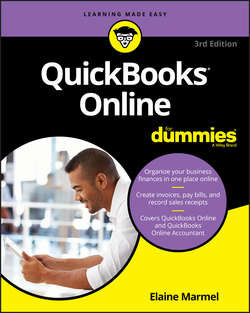Читать книгу QuickBooks Online For Dummies - Marmel Elaine - Страница 5
На сайте Литреса книга снята с продажи.
Part 1
Getting Started with QBO and QBOA
Comparing interfaces
ОглавлениеQBO and QBOA were initially written and optimized to be used in the major web browsers – Chrome, Firefox, Safari, and Internet Explorer. Later, Intuit added QBO apps that you can use for Windows, Mac, and Android mobile devices. In this section, you explore what QBO and QBOA look like in a browser and in the Windows app.
In addition to using the QBO mobile apps for iOS and Android, you also can access QBO from your mobile device’s browser at https://qbo.intuit.com.
In a browser, an open company in QBO looks similar to the one shown in Figure 1-1. I cover the interface in more detail in Chapter 3, but for the time being, the most important thing to notice is the Navigation bar that runs down the left side of the screen. If you've been a QuickBooks desktop user and you’ve used the Left Icon bar in that product, you might find the Navigation bar a familiar tool. The Left Icon bar and the Navigation bar work the same way; you click a link in either of them to navigate to a portion of the program.
FIGURE 1-1: An open company in QBO.
Clicking the arrow in the Navigation bar enables you to collapse the Navigation bar to view just the icons (and clicking it again expands the Navigation bar back to the view in Figure 1-1). When you collapse the Navigation bar (you see an example of it collapsed in Chapter 3), you have more screen real estate to view the right side of the QBO interface.
At the time I wrote this, the arrow feature was being tested in QuickBooks Labs. I include this feature in some of the figures because I want to give you an idea of things that might make their way into the software. You, too, can turn on features being tested in the lab; see Chapter 3 for details. And, in Chapter 3, I’ll show you the new navigation centers being tested for QBO – another feature currently available via QuickBooks Labs.
At the top of the screen, you see tools that help QBO users create transactions, search for existing transactions, and view recent transactions.
Figure 1-2 shows what an accountant sees immediately upon logging in to QBOA. The Navigation bar changes to support an accountant’s needs; you can read more about the QBOA interface in Chapter 11.
FIGURE 1-2: The first view an accountant sees when he opens QBOA.
When an accountant opens a client’s company from within QBOA (see Figure 1-3), the interface resembles what a client sees, with some minor differences. Compare Figure 1-1 with Figure 1-3. First, you know you’re using QBOA because the top of the Navigation pane shows QuickBooks Accountant. Second, the tools used to search for a transaction, go to a report, and view recent transactions are combined into one Search box near the right side of the screen. And third, the Accountant Tools menu (the briefcase icon) displays tools not found in QBO that help accountants manage client companies.
FIGURE 1-3: An open company in QBOA.
Even though an open company looks a bit different depending on whether it is opened using QBO or QBOA, the basic functionality doesn’t really change, other than accountants having more options than end users have.
Because QBOA contains functionality that QBO doesn’t have, I’ve organized this book so that QBO users can focus on Part 2 when using the product, and QBOA users can use the information in both Parts 2 and 3 to work with a company online.
